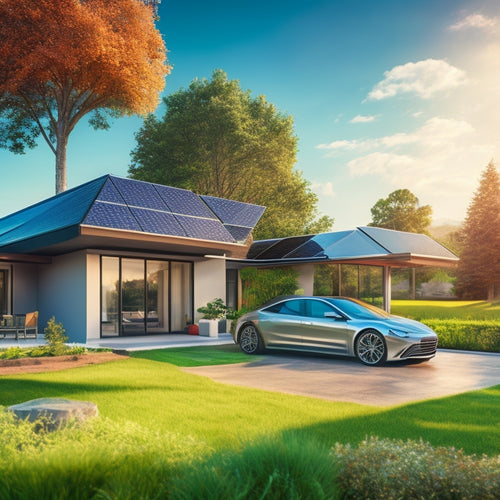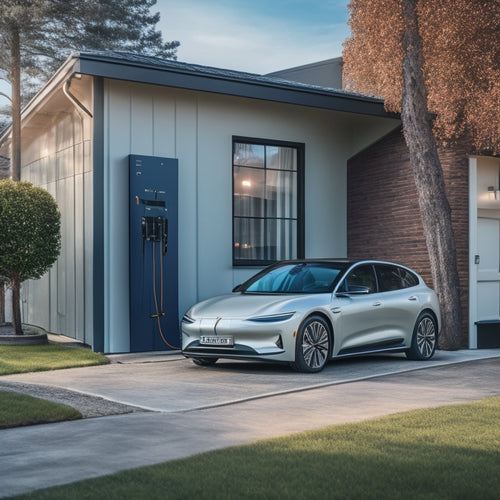
7 Essential Steps for Solar Power Systems With Battery Backup
Share
You're about to design and implement a solar power system with battery backup, so it's vital to follow the essential steps. First, assess your energy requirements by gathering past utility bills and identifying high-energy appliances to determine the system's size and backup needs. Next, select the right solar panels and battery type based on energy efficiency, durability, and reliability. Then, design a safe electrical system with grounding and safety equipment, and install the system correctly with proper cable management and ventilation. After that, plan for energy storage capacity, monitor and maintain the system's performance, and confirm scalability for future load demands. By following these steps, you'll be well on your way to a reliable and efficient solar power system with battery backup - and there's more to investigate to confirm peak performance.
Key Takeaways
- Assess energy requirements by analyzing utility bills and identifying high-energy appliances to determine the right solar power system size.
- Choose the right solar panels and battery type based on efficiency, energy density, and lifespan to ensure reliable energy production and storage.
- Design a safe electrical system with proper grounding, cable management, and safety inspections to prevent electrical shocks and faults.
- Monitor system performance regularly to identify inefficiencies, address battery health, and track energy production and consumption metrics.
- Plan for system scalability by selecting components that allow for easy future expansion and considering modular designs for flexible growth options.
Assess Your Energy Requirements
To determine the size of your solar power system with battery backup, you need to evaluate your energy requirements. This involves calculating your total energy consumption and identifying your peak usage periods.
Start by gathering your past utility bills to get an idea of your average daily energy consumption. Next, identify the appliances and devices that use the most energy, such as refrigerators, air conditioners, and electric water heaters.
Consider your energy usage patterns, including the time of day and duration of usage. For instance, do you use most of your energy during the day or at night? Do you have any high-power devices that require a lot of energy to operate?
Understanding your energy consumption patterns will help you determine the size of your solar power system and the type of battery backup you need. By accurately evaluating your energy requirements, you can guarantee that your solar power system meets your needs and provides a reliable source of power during outages or emergencies.
Choose the Right Solar Panels
Selecting the right solar panels for your system is crucial, as they directly impact your energy production and overall system performance.
You'll want to take into account solar panel efficiency, which is measured by the amount of energy produced per unit area. Higher efficiency panels can generate more power in smaller spaces, making them ideal for systems with limited roof space. However, they're often more expensive.
When choosing solar panels, you should also take into account the type of installation. Will you be installing them on a rooftop or in a ground-mounted system? This will affect the type of panel you need, as well as the installation process.
Panel installation tips include guaranteeing a secure and watertight mounting system, and using a compatible inverter to maximize energy production.
Additionally, take into account the warranty and durability of the panels, as well as the manufacturer's reputation and customer support.
Select a Suitable Battery Type
You'll need to take into account two key factors when selecting a suitable battery type for your solar power system: the battery chemistry options and the deep cycle battery needs.
Battery chemistry options include lead-acid, lithium-ion, and nickel-cadmium, each with its own advantages and disadvantages.
Battery Chemistry Options
When evaluating solar power systems with battery backup, the battery chemistry you choose plays a critical role in determining the overall performance, lifespan, and cost of your system.
You'll need to take into account factors like energy density, depth of discharge, and lifespan to select the most suitable battery type for your needs.
Lithium-ion batteries offer several advantages, including high energy density, long lifespan, and low maintenance. They're ideal for daily cycling applications, but their higher upfront cost might be a barrier for some users.
On the other hand, lead-acid batteries are a more affordable option, known for their longevity and reliability. They're a good choice for backup systems that don't require frequent cycling. However, their lower energy density means they take up more space and may require more maintenance.
Ultimately, the choice between lithium-ion and lead-acid batteries depends on your specific requirements and budget.
Take into account your energy needs, the frequency of cycling, and the available space for your battery bank.
Deep Cycle Battery Needs
Considering your energy needs and cycling frequency, it's time to determine the deep cycle battery requirements for your solar power system with battery backup.
You'll want to select a suitable battery type that meets your specific needs.
When choosing a deep cycle battery, consider the following key factors:
-
Battery Capacity: Verify the battery can store enough energy to cover your nightly usage and provide backup power during outages.
-
Cycle Life: Look for batteries with a high number of charging cycles to maximize battery lifespan.
-
Depth of Discharge (DOD): Choose a battery with a high DOD to increase the amount of usable energy.
-
Charging Speed: Select a battery that can handle the charging speed of your solar power system.
-
Operating Temperature: Consider batteries with a wide operating temperature range to guarantee peak performance in various environments.
Design a Safe Electrical System
When designing a safe electrical system for your solar power system with battery backup, you'll need to prioritize electrical shock prevention and grounding system design.
You must guarantee that your system is designed to prevent electrical shock hazards, which can be fatal or cause serious injury.
A well-designed grounding system will help protect you and your equipment from electrical faults and surges.
Electrical Shock Prevention
Three-pronged safety measures are vital to prevent electrical shock in solar power systems with battery backup.
You must prioritize safety to guarantee a secure and reliable system. Electrical shock can be fatal, so it's imperative to take preventative measures seriously.
To prevent electrical shock, you should:
- Confirm all electrical components are installed and maintained according to the manufacturer's instructions and industry standards
- Use safety equipment such as gloves, safety glasses, and insulated tools when working with electrical systems
- Implement lockout/tagout procedures to prevent accidental startup of systems during maintenance
- Provide first aid training to personnel and confirm a first aid kit is readily available
- Conduct regular safety inspections and risk assessments to identify potential hazards and take corrective action
Grounding System Design
Frequently, a well-designed grounding system is the cornerstone of a safe electrical system in solar power setups with battery backup. As you design your system, you'll need to confirm that your grounding system is up to par. This involves selecting the right grounding materials, such as copper or aluminum, and implementing effective grounding techniques.
When choosing grounding materials, consider factors like conductivity, corrosion resistance, and durability. Copper, for instance, is an excellent conductor, but it can be prone to corrosion. Aluminum, on the other hand, is more resistant to corrosion, but it isn't as conductive. You'll need to weigh these factors and select the material that best suits your system's needs.
In terms of grounding techniques, you'll need to decide on the type of grounding system to use. Options include a solidly grounded system, an ungrounded system, or a resistance-grounded system. Each has its advantages and disadvantages, so it's crucial to understand the implications of each before making a decision.
Plan for Energy Storage Capacity
To guarantee a reliable and efficient solar power system with battery backup, you need to plan for energy storage capacity that meets your specific needs. This involves determining the amount of energy you need to store to secure uninterrupted power supply during periods of low solar production or grid outages.
To achieve energy efficiency, consider the following factors when planning for energy storage capacity:
-
Daily energy usage: Calculate your daily energy consumption to determine the required battery capacity.
-
Peak load management: Identify peak energy usage periods and plan for sufficient energy storage to meet those demands.
-
Backup power duration: Decide how long you want your battery backup to last during power outages or low solar production.
-
Depth of discharge: Determine the maximum depth of discharge for your batteries to secure their longevity.
-
System scalability: Plan for future energy needs and select a system that can be easily scaled up or down as needed.
Install the System Correctly
Now that you've planned your energy storage capacity, it's time to bring your solar power system with battery backup to life by installing it correctly. This vital step requires attention to detail and adherence to best practices to guarantee a safe and efficient system.
Proper installation techniques are essential to avoid common mistakes that can lead to system failure, fire hazards, or even electrical shock. Here are some key considerations to keep in mind:
| Installation Consideration | Best Practice |
|---|---|
| Cable Management | Use cable ties and secure cables to prevent damage and promote airflow |
| Battery Placement | Place batteries in a well-ventilated area, away from heat sources and flammable materials |
| Grounding | Confirm proper grounding of the system to prevent electrical shock and system failure |
Monitor and Maintain the System
As you've successfully installed your solar power system with battery backup, guaranteeing its ideal performance relies on regular monitoring and maintenance.
This vital step helps you identify potential issues before they become major problems, making certain your system operates at its best.
To guarantee optimal performance, you should:
- Perform regular system monitoring to track energy production, consumption, and storage
- Conduct performance analysis to identify areas for improvement
- Check and clean panels to guarantee maximum energy harvesting
- Inspect and test electrical connections to prevent faults
- Update system software and firmware to guarantee you have the latest features and security patches
Frequently Asked Questions
Can I Use a Solar Power System With a Septic System?
You can successfully integrate a solar power system with your septic system, ensuring seamless septic system integration while maintaining peak solar energy efficiency, as both systems operate independently without interference.
Are Solar Power Systems Compatible With Well Water Systems?
You're wondering if your well water system is compatible with solar power - the answer is yes, as long as you choose a solar-compatible water pumping system that can handle the variable power output of your solar array.
Do I Need a Backup Generator With a Battery Backup System?
You're wondering if a backup generator is necessary with a battery backup system. While batteries provide reliable power during short outages, they have limitations; a generator's benefits, like extended runtime and high-power capacity, make it a worthwhile addition for prolonged grid failures.
Can I Add More Solar Panels to My Existing System Later?
You can seamlessly scale up your solar setup, adding more panels to your existing system later, as long as you guarantee system compatibility and consider solar panel expansion capabilities during the initial installation process.
Will a Solar Power System Work During a Power Grid Failure?
You'll achieve grid independence and energy resilience with a solar power system that includes a battery backup, ensuring you have power during a grid failure, and enjoying uninterrupted energy supply when you need it most.
Conclusion
By following these 7 essential steps, you'll be well on your way to a reliable solar power system with battery backup. Did you know that according to the International Energy Agency, the global energy storage market is projected to reach 230 gigawatts by 2025? With the right planning and installation, you can tap into this growing trend and enjoy a sustainable, efficient energy solution that meets your needs and reduces your carbon footprint.
Related Posts
-

What Solar Panels Work Best With EVS Online?
When shopping for solar panels online to power your electric vehicle, look for high-efficiency models that can withst...
-

5 Essential Tips for Buying EV Charging Systems Online
When purchasing an EV charging system online, you'll want to make sure you're making an informed decision. First, det...
-

Why Invest in Residential Solar Panel Systems?
By investing in a residential solar panel system, you'll harness renewable energy, reducing your carbon footprint and...


